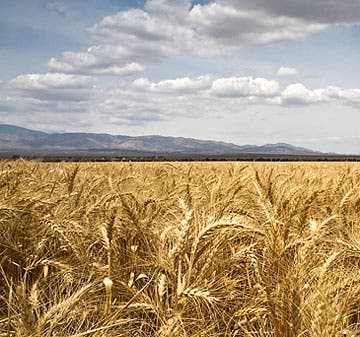
Trying to understand the overall effect of climate change on our food supply can be difficult. Increases in temperature and carbon dioxide (CO2) can be beneficial for some crops in some places, but overall changing climate patterns lead to frequent droughts and floods that put a severe strain on yields. It’s not all about production, however. Researchers at University of California, Davis found that rising CO2 levels are inhibits plants’ ability to assimilate nitrates into nutrients, altering their quality for the worse. Our whole food chain relies on the proteins found in plants, whose energy we assimilate directly or from animals that eat the same plants. Consequently, crop quality in the face of global warming is an aspect that needs to be thoughtfully addressed.
“Food quality is declining under the rising levels of atmospheric carbon dioxide that we are experiencing,” said the study’s lead author Arnold Bloom. “Several explanations for this decline have been put forward, but this is the first study to demonstrate that elevated carbon dioxide inhibits the conversion of nitrate into protein in a field-grown crop.”
Nitrogen and CO2
Food crops use nitrogen to produce the proteins that are vital for human nutrition. Nitrogen is the mineral element that plants and other living organisms require in the greatest quantity to survive and grow. Plants obtain most of their nitrogen from the soil and, in the moderate climates of the United States, absorb most of it through their roots in the form of nitrate. In plant tissues, those compounds are assimilated into organic nitrogen compounds, which have a major influence on the plant’s growth and productivity.
[ALSO READ] We’re not growing enough food to feed the world of 2050
Previously, scientists proved that nitrates assimilation is inhibited by carbon dioxide in the leaves of grain and non-legume plants, however the present study marks the first time that this relation was investigated in field-grown crops.
Samples of wheat that had been grown in 1996 and 1997 at the Maricopa Agricultural Center in Arizona were analyzed by the UC Davis researchers. At that time, carbon dioxide-enriched air was released in the fields, creating an elevated level of atmospheric carbon at the test plots, similar to what is now expected to be present in the next few decades. Almost two decades later, the UC Davis researchers returned to these samples and subjected them to chemical analysis that was not available at the time of harvesting.
[RELATED] Climate change causes lower crop yields than previously thought
Three different measures of nitrate assimilation confirmed that the elevated level of atmospheric carbon dioxide had inhibited nitrate assimilation into protein in the field-grown wheat. It’s safe to assume that other food crops like barley, rice, and potatoes may be subjected to the same risks, though the same experiment needs to be repeated for each of these.
“These field results are consistent with findings from previous laboratory studies, which showed that there are several physiological mechanisms responsible for carbon dioxide’s inhibition of nitrate assimilation in leaves,” Bloom said.
Historical records have documented that the concentration of carbon dioxide in Earth’s atmosphere has increased by 39 percent since 1800. If current projections hold true, the concentration will increase by an additional 40 to 140 percent by the end of the century.
Extrapolating, the researchers found that, in all, global food proteins available for human consumption could drop by as much as 3% in the coming decades as a result of rising carbon dioxide levels. While heavy nitrogen fertilization could partially compensate for this decline in food quality, it would also have negative consequences including higher costs, more nitrate leaching into groundwater, and increased emissions of the greenhouse gas nitrous oxide.
The findings were reported in the journal Nature Climate Change.


